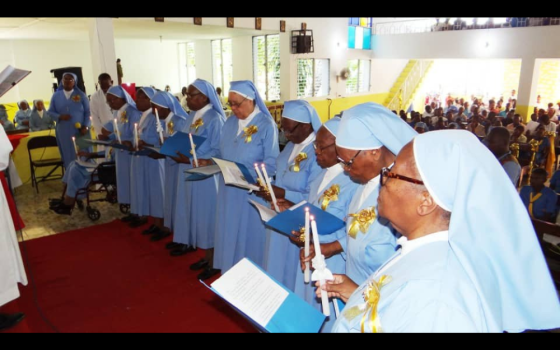
As I see it, the Leadership Conference of Women Religious, which gathers next week in New Orleans, faces a bleak choice: either die or survive at a great cost to its integrity and dignity.
The Vatican has thrown down the gauntlet. The choice is stark: acquiesce to a “doctrinal assessment” of leadership conference views -- on women’s ordination, the primacy of Roman Catholicism and homosexuality – or reject the probe as an unwarranted fishing expedition bent on putting the organization out of business.
What we have here, I believe, could be the last major struggle over a way of understanding what it means to be Catholic. Sisters have retained more of Vatican II ethos and spirit than any group in the church, in the face of formidable opposition to large segments of it by the last two popes.
If Rome succeeds in wrecking this last organizational remnant of Vatican II, then all of American Catholicism suffers a great loss. Yet the will to resist appears to have dissipated. Without active protest, LCWR, as it’s been known, will exist no more. Voices of appeasement who counsel trust in Vatican intentions sound sadly out of touch with Rome’s hard line aims.
--------------------------------------------------------------------------------------------------------------------------------------------------------------------------
Vatican, U.S. Women religious tensions go back decades
--------------------------------------------------------------------------------------------------------------------------------------------------------------------------
Meanwhile, the two investigations of sisters are in full stride, couched in terms of routine check-ups. One examines the “quality of life” in sisters’ congregations. It covers the chief components of governance, work and spirituality, the areas that became the touchstones of renewal. The other is aimed squarely at the leadership conference, long regarded as a thorn in the Vatican’s hide. Having failed for decades to break the Conference of its Vatican II identity, the latest offensive appears determined to finish the job.
Renewal was the word that encapsulated that search for the new life mandated by the Council. It is a word rarely spoken any more because its practice belongs largely to the past. But leadership conference has continued to uphold many of its values.
The superiors of the congregations have maintained near total silence in response to the investigations. Some believe the Vatican’s assurances that they have nothing to worry about. And because they believe they’ve done nothing wrong, they don’t appear worried.
If they don’t look squarely at what’s happening and speak out against it, however, I think the struggle to preserve even a semblance of the LCWR’s vibrant past will be lost. This dynamic conference, born in controversy because the Vatican objected strenuously to the term “leadership” in its name change, could forfeit its legacy of defending not only sisters but a wider cohort of Catholic women and American Catholicism’s stake in renewal.
The seeds of the Leadership Conference of Women Religious subversion were sewn in 1971 when opponents organized a separate group called Consortium Perfectae Caritatis. By 1992, the group had won official recognition from Rome and renamed itself the Council of Major Superiors of Women.
The alternative conference portrayed itself as strictly traditional and sharply opposed to the liberal direction of LCWR. The United States thus became the only country in the world with two recognized sister organizations. Only one of them, of course, found favor at the Vatican. The liberal group was suspected of promoting “radical feminism,” selling out to secular culture and questioning authority. To many prelates, the women's leadership conference was both vexing and threatening.
The insurgent group became the wedge. Over the years, it would employ various means to take advantage of a women's religious group weakened by constant criticism from church officials and flagging interest in the ideals of Vatican II by those who tired of the fight. Among its latest efforts is to show that young women are flocking to “traditional” orders that obey the old rules in contrast to the sharp losses among communities involved in renewal. The truth is something different.
A few years ago, I did a book on the fate of American sisters from before Vatican II to the start of the 21st century. I wasn’t looking for particular causes of the dramatic fluctuations in numbers of sisters and their welfare, but understood from initial research that there were many factors involved.
The establishment of the CMSW was one of the principal events that led me to the conclusion that the church’s hierarchy had been the chief reason that renewal hadn’t be able to finish the task and therefore contributed mightily to the decline of so many sister communities.
Critics of my conclusion said it was simplistic and placed blame in the wrong place. Some said sisters had brought on the crisis themselves by betraying the true mission of religious life – and the Council’s intent -- by living outside the convent, pursuing a variety of professions rather than pursuing a common service and choosing alternative forms of worship (not surprisingly, similar “abuses” are now cited in defense of the investigation). The damage caused by painful divisions in many orders over these big changes was cited by critics as further proof that sisters had brought it on themselves.
Unless sisters became obedient and returned to prescribed roles, the critics said, order couldn’t be restored and I had sorely misread the history.
Rightly or wrongly, not only hasn’t my thinking in this regard changed but the investigation strengthens it. Having failed otherwise to persuade LCWR and many of its leaders to abandon its commitment to renewal, as they interpreted it from the Vatican II document addressed to them (the only group in the church singled out in a discreet document), the Vatican appears to have chosen another blunt instrument to instill cooperation.
Depending on how the leadership conference and various sister leaders respond, the Vatican may have already accomplished its end by injecting enough intimidation to coax many reluctant sisters to go along with the directives quietly.
I’m in no position to judge whether or not silence is justified and I deeply respect the consciences of those who have actually lived through a long period of trial. Some sisters say that speaking out could jeopardize the welfare of their communities, especially their oldest members; others feel that a good faith effort is called for; still others hope that being inconspicuous will reduce chances that the Vatican operatives will come calling. Hunker down and wait till it blows over. But it’s difficult to see charitable purposes as the motivating force.
Without resolve to resist, it seems quite likely that the LCWR will be swallowed up into the conservative religious women's council that appears to be close to achieving victory in a contest for hearts and minds over the character of Catholicism that was triggered by the Vatican’s installing of the rival group.
The LCWR could lose its character even if a shell of its structure remained. But make no mistake: Rome is committed to resolving this dispute in its favor.
Those who trust that the best response is peaceful non-resistance or resignation may be right. Who wouldn’t like to have answers to some of the serious troubles that hamper so many communities, even if it required compromise? At the same time, trust and wishful thinking could worsen those troubles. As it is, Rome has given these women so little support that there’s little to take away. On the issue of obedience, Rome may have already accomplished its goal.
Ken Briggs has written extensively on Catholicism as a member of the staff of The New York Times and many other publications. He is the author a recent book, “Double Crossed: Uncovering the Catholic Church’s Betrayal of American Nuns.”


